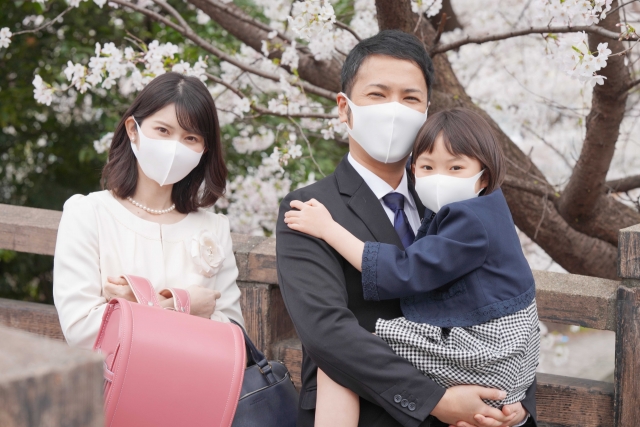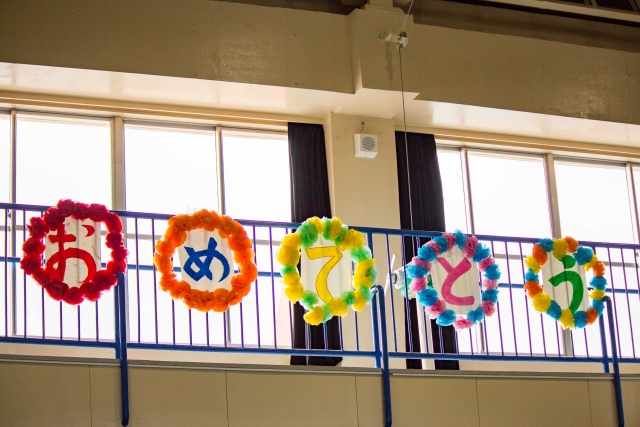As April is the start of the school year in Japan, many people will be preparing for the upcoming entrance ceremonies for their children. There is a kindergarten (yochien) entrance ceremony, along with elementary school and beyond. If your child is attending a Japanese school, then you will want to be prepared.

What to expect at an entrance ceremony
The entrance ceremony is called “nyuugakushiki” and is considered quite a big deal. The Japanese for this is 入学式 (にゅうがくしき).
Parents should arrive to the school at the set time and follow all the other parents to be seated in the hall. Kids will usually pose for photos in front of the school with their parents either beforehand or afterwards.
The ceremony is fairly standard – the principal will give a speech, and sometimes there will be speeches by other teachers or an older student. You don’t really need to follow this so it’s okay if you can’t speak Japanese. The speaker will also introduce the teachers who will be teaching the new students, so this may be your first glimpse of your child’s teacher.
After that, it depends on the institution. There will often be songs sung, such as the school song, or the national anthem. At our kindergarten, they sang some songs along with the kids, and then had all the parents and kids pose for a photo. In elementary schools, they may do a roll call where every new student should respond to their name. Make sure your kids know how to pronounce their name in Japanese if they are foreign (as in katakana pronunciation).
After this ceremony, the students then get shown around the school by a teacher or older student. They’ll see their classroom or homeroom and meet their new teacher for the year. They may also receive their textbooks at this time if it is elementary school or above.
Once the kids have been on the “tour”, it’s actually time to go home. The entrance ceremony day is not a regular school day, and so once it’s over, the school day is over. Many families go out to eat lunch afterwards to celebrate.

What to wear to an entrance ceremony

Kids
Kids should attend the ceremony looking well presented. In primary school, this can be a suit for boys, and a pretty formal dress for girls. The girls usually wear a formal but cute blazer/cardigan over their dress as the weather is still cold in April. These outfits are sold as a set in many shops around January to March, and can be found at varying price points. On the cheap end are places like Nishimatsuya where you can pick up an outfit for around 4,000 yen, while the sky is the limit at fancy department stores. You could also look for secondhand options at places like Second Street or Mercari. If your child doesn’t like to dress too formally, it’s okay to choose the nicest of their normal dresses/pants and shirts, and just “dress them up” a bit with a smart blazer or cardigan. Shoes should be clean and formal shoes, but they will change into their uwabaki so this isn’t very important.
For kindergarten ceremonies, the kids should wear the school uniform.

Men
Men have it quite easy, as they can just wear a suit to all occasions. For April ceremonies when the weather is cool, a tie is generally also expected. Both parents should remember slippers or indoor shoes to wear in the hall.

Women
For woman, it is a little but more difficult. There are some very elite schools where almost everyone will wear a navy blue dress or suit without deviation. For most schools and kindergartens though, you can just dress nicely. Women no longer need to stick to dresses – suits or skirts are also okay. Spring colours such as pastels, and light grey or blue are popular for the nyuugakushiki. Just make sure you are not dressed too casually and you should be fine. If in doubt, err on the more conservative side. Below are some outfit examples.



What should you bring?
The school will tell you in advance if you need to bring the child’s stationary and school supplies. Other than that, just bring:
- Indoor shoes/slippers for parents
- Uwabaki for kids
- A bag to carry your outside shoes in (maybe)
- A big bag in case you need to carry home textbooks
- Randosel backpack
- Emergency hood (bousai zukin) (depends on the school)
If you are enrolling your child into a Japanese school, kindergarten or daycare, Omakase Helper can assist you with any language difficulties! Just contact us.


Comments are closed